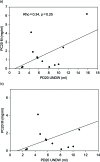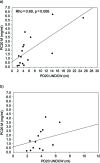Comparison of bronchial responsiveness to ultrasonically nebulized distilled water (UNDW), methacholine, and ultrasonically nebulized distilled cold water (UDCW) in patients with sulfur mustard gas-induced asthma
- PMID: 17558630
- PMCID: PMC2409175
- DOI: 10.1080/15563650701382730
Comparison of bronchial responsiveness to ultrasonically nebulized distilled water (UNDW), methacholine, and ultrasonically nebulized distilled cold water (UDCW) in patients with sulfur mustard gas-induced asthma
Abstract
Objective: To evaluate bronchial challenges using three different stimuli as screening tools for bronchial hyper-responsiveness in sulfur mustard gas-induced asthma.
Design: Randomized, cross-over clinical study.
Setting: University hospital.
Patients: Eighteen veterans with mustard gas-induced asthma and 18 normal veterans as the control group.
Intervention: Pulmonary function tests and inhalation challenges with ultrasonically nebulized distilled water (UNDW), methacholine, and ultrasonically nebulized cold water (UNDCW) were performed on all patients and subjects.
Results: Six mustard gas-induced asthmatic veterans did not respond to a 20% in FEV(1) after distilled water (13.3%), and two of them (11.11%) did not respond with distilled cold water; all responded with methacholine. Only one healthy subject developed a PC20 FEV(1) after methacholine but did not with both distilled water and distilled cold water challenges. The asthmatic patients were sensitive to distilled water with a median PD20 of 7.24 +/- 3.83 ml (range 2.54 ml to 15.83 ml), and sensitive to cold water with a median PD20 of 6.42 +/- 6.24 ml (range 1.92 ml to 25.15 ml). The median PC20 methacholine was 1.90 +/- 1.88 mg/ml (range 0.14 mg/ml to 6.20 mg/ml). In patients with a positive response to the distilled water challenge test, no significant correlation was found between PC20 of methacholine and PD20 of distilled water (Rho = -0.34, p = 0.25), whereas in patients whose responses to distilled cold water (DCW) were positive, PD20 of distilled cold water (DCW) correlated well with PC20 of methacholine (Rho = -0.69, p = 0.006).
Conclusion: Overall, the methacholine challenge test is the best method to distinguish these asthmatic patients from normal subjects in this study. When compared to the methacholine challenge, although the airway response to ultrasonically nebulized distilled cold water test was somewhat less sensitive, it may be used as a simple, fast, inexpensive, and relatively reliable method to predict the absence of asthma in sulfur mustard gas-induced asthma.
Figures


Similar articles
-
Relationship between airway reactivity induced by methacholine or ultrasonically nebulized distilled cold water and BAL fluid cellular constituents in patients with sulfur mustard gas-induced asthma.J Aerosol Med. 2007 Fall;20(3):342-51. doi: 10.1089/jam.2007.0589. J Aerosol Med. 2007. PMID: 17894540 Clinical Trial.
-
[Standard technical specifications for methacholine chloride (Methacholine) bronchial challenge test (2023)].Zhonghua Jie He He Hu Xi Za Zhi. 2024 Feb 12;47(2):101-119. doi: 10.3760/cma.j.cn112147-20231019-00247. Zhonghua Jie He He Hu Xi Za Zhi. 2024. PMID: 38309959 Chinese.
-
Comparison of bronchial challenge with ultrasonic nebulized distilled water and hypertonic saline in children with mild-to-moderate asthma.Eur Respir J. 1996 Sep;9(9):1896-901. doi: 10.1183/09031936.96.09091896. Eur Respir J. 1996. PMID: 8880109 Clinical Trial.
-
Problems and progress in measuring methacholine bronchial reactivity.Clin Exp Allergy. 1998 Apr;28 Suppl 1:15-9; discussion 32-6. doi: 10.1046/j.1365-2222.1998.0280s1015.x. Clin Exp Allergy. 1998. PMID: 9641585 Review. No abstract available.
-
Bronchoprovocation in children.Pediatrician. 1991;18(4):269-79. Pediatrician. 1991. PMID: 1796015 Review.
References
-
- New York: Security Council of the United Nations; 1986. Reports of specialists appointed by the Secretary General to investigate allegations by the Islamic Republic of Iran concerning the use of chemical weapons. document S/16433. - PubMed
-
- Emad A, Rezaian GR. The diversity of the effects of sulfur mustard gas inhalation on respiratory system 10 years after a single, heavy exposure: Analysis of 197 cases. Chest. 1997;112:734–8. - PubMed
-
- Wormser U. Toxicology of mustard gas. Trends Pharmacol Sci. 1991;12:164–7. - PubMed
-
- Calvet JH, Jarreau PH, Levame M, Ortho MP, Lorino H, Harf A, Macquin-Mavier I. Acute and chronic respiratory effects of sulfur mustard intoxication in guinea pig. J Appl Physiol. 1994;76:681–8. - PubMed
-
- Chevillard M, Lainee P, Robineau P, Puchelle E. Toxic effects of sulfur mustard on respiratory epithelial cells in culture. Cell Biol Toxicol. 1992;8:171–81. - PubMed
Publication types
MeSH terms
Substances
LinkOut - more resources
Full Text Sources
Medical
